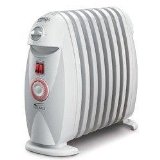Oil filled radiator buying guide
Welcome to our oil filled radiator buying guide. Here you can find advice on buying the ideal oil filled radiator to suit your heating needs.
Oil filled radiators are portable electric heaters that are filled with oil which is heated by one or more electric elements. The oil is permanently sealed and never requires refilling.
Unlike other forms of electric heating, oil filled radiators provide a mixture of radiant and convected heat which means that they don’t just heat the air in the room, they also directly heat the objects within it. This gives the room a comfortable warmth without drying out the air.
Uses of oil filled radiators
Oil filled radiators are ideal for heating single rooms and can either be used where there is no existing heating, or in addition to a central heating system when one area needs to be warmer than the rest of the house.
There is a wide range of models, from a number of manufacturers, available in many shapes, sizes, colours and power outputs. Some of the most popular brands are DeLonghi, Dimplex and Honeywell. Most oil filled radiators are designed to be portable and are fitted with wheels so they can easily be moved from one room to another, or stored out of the way during the warmer months.
Oil filled radiator benefits
Oil filled radiators provide a safe heating source because the heating elements are enclosed. Most also include an overheat safety cut-off in case the appliance is accidentally knocked over or covered up. They are also silent in use and provide a comfortable heat because they neither dry nor add moisture to the air. Unlike fan heaters, they do not distribute dust around the room either.
Most oil filled radiators include a thermostat so that they can be set to heat the room to a comfortable temperature and maintain it without any further user intervention. Some also have a timer so which could be used to automatically warm a bedroom before you wake up or go to bed, but remain off during the day when the room is empty.
Oil filled radiators are very easy to set up. Some models might require feet clipping into place before they are first used, but after this basic assembly it is just a case of plugging them in. They are also generally maintenance free so they do not require any servicing.
Electric heaters are 100% efficient, so all the electricity they use is converted into heat. Electricity tends to cost more than gas per unit, so it would be an expensive way to heat your entire house, but for heating only one or two rooms, portable electric heaters can work out far cheaper.
The overall power consumption of the radiator will depend on the room size and temperature rather than the maximum power output of the heater. i.e. If it only takes 500W of power to maintain a room at the desired temperature, the radiator will only use 500W, even if it has a maximum power output greater than this.
The oil contained in the radiator can release its stored heat over some time, which means that they provide a very even heat, unlike some other types of heater which can cause the temperature to constantly cycle between too hot and too cold.
Oil filled radiator disadvantages
Oil filled radiators have very few disadvantages. One that is mentioned frequently is that they are slower to warm up than some other types of heaters. However, they only take a few minutes to reach operating temperature, and if supplied with a timer, the room can automatically be heated before you need it.
Oil filled radiators are generally larger than fan heaters of a similar power rating, although some of the taller models only require a similar floorspace. The increased size is the main trade-off to achieve silent heating in the safest way.
Key features
Thermostat: The thermostat maintains the room at a temperature of your choice. Nearly all oil filled radiators have a thermostat.
Timer: Some of the simpler timers are only able to turn the radiator on once, at a preset time for a fixed duration. Others are able to set multiple intervals that can be used to heat a room in the morning and evening for example.
Power output: This is measured in Watts (1KW = 1,000W) and generally ranges from 400W to 3KW. The more powerful radiators are larger than the lower power ones, but are more suitable for heating larger rooms.
Power levels: Some oil filled radiators have multiple power levels controlled by a switch. e.g. 500W, 1,000W and 1,500W. This can be used to heat a cold room quickly on full power and then reduce the power output to maintain the heat.
Remote control: These are normally able to adjust the temperature and turn the radiator on and off. Some of the better models, such as the DeLonghi Dragon 3, are also able to set the timer using the remote control.
Caster wheels: Many oil filled radiators have small caster wheels so they can easily be moved from room to room.
Tilt protection: If the radiator is knocked over, tilt protection will turn it off.


